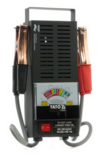I bought this some years ago, and it is rather clever. You connect it across an engine starter battery, and it checks the condition of the battery, well enough, based on the CCA. It suggests it tests various battery types, but insists on knowing the battery CCA, with a minimum setting of 100CCA.
Not all batteries include a CCA figure, simply an aH at various rates - so how can I get an idea of the condition of one of these batteries, not designed as an engine starting battery.
This is the gadget's manual - https://mans.io/item/ancel/ba201
Testing a none engine starter battery, it will report a tested CCA, and the battery voltage, indicate if it has dead cells, etc. but what I need to know, is the aH.
Not all batteries include a CCA figure, simply an aH at various rates - so how can I get an idea of the condition of one of these batteries, not designed as an engine starting battery.
This is the gadget's manual - https://mans.io/item/ancel/ba201
Testing a none engine starter battery, it will report a tested CCA, and the battery voltage, indicate if it has dead cells, etc. but what I need to know, is the aH.




